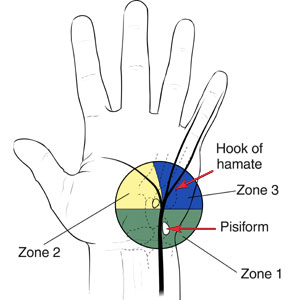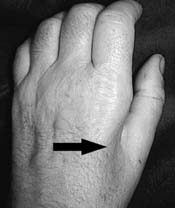
Ulnar Tunnel Syndrome of the Wrist
Ulnar tunnel syndrome occurs when the ulnar nerve is compressed at the wrist. The ulnar nerve is one of the three main nerves that provide feeling and function to the hand. It travels from your neck down into your hand, and can be constricted in several places along the way.
When pressure on the nerve occurs at the wrist, it causes numbness and tingling in the little finger and along the outside of the ring finger. In addition, ulnar tunnel syndrome can sometimes cause weakness of hand pinch and grip.
CauseThe most common cause of ulnar tunnel syndrome is a soft tissue tumor, usually a benign (noncancerous) cyst called a ganglion which originates from the wrist joint.
Other frequent causes are repetitive trauma or chronic pressure applied to the area of the hand. Repetitive trauma can result from the use of a jackhammer. Chronic pressure can occur in the hand of a bicyclist against the handlebars.
 Ulnar tunnel syndrome can result from chronic pressure on the nerve in the area of the hand highlighted above.
Courtesy of Griffin LY (ed): Essentials of Musculoskeletal Care. 3rd Ed. Rosemont, IL. American Academy of Orthopaedic Surgeons, 2005
Symptoms
Ulnar tunnel syndrome can result from chronic pressure on the nerve in the area of the hand highlighted above.
Courtesy of Griffin LY (ed): Essentials of Musculoskeletal Care. 3rd Ed. Rosemont, IL. American Academy of Orthopaedic Surgeons, 2005
Symptoms
Symptoms develop gradually. Weakness and increasing numbness, particularly on the little finger side of the hand are usual signs of ulnar tunnel syndrome. The degree of weakness and numbness depends on the location of the pressure point. Pain may or may not be present.
As the syndrome progresses, it may become more difficult to open jars, hold objects, or coordinate the fingers during such tasks as typing or playing a musical instrument.
Doctor ExaminationPhysical Examination
 The arrow shows an area of muscle wasting that suggests ulnar nerve entrapment at the wrist.
Courtesy of Griffin LY (ed): Essentials of Musculoskeletal Care. 3rd Ed. Rosemont, IL. American Academy of Orthopaedic Surgeons, 2005
Your doctor will examine your hand looking for common signs of ulnar tunnel syndrome, such as the muscle is diminishing or wasting (atrophy), muscle weakness, and dry skin in the spaces between the fingers. Your doctor may tap his or her finger over the ulnar nerve to determine whether this causes a tingling sensation (Tinel sign).
The arrow shows an area of muscle wasting that suggests ulnar nerve entrapment at the wrist.
Courtesy of Griffin LY (ed): Essentials of Musculoskeletal Care. 3rd Ed. Rosemont, IL. American Academy of Orthopaedic Surgeons, 2005
Your doctor will examine your hand looking for common signs of ulnar tunnel syndrome, such as the muscle is diminishing or wasting (atrophy), muscle weakness, and dry skin in the spaces between the fingers. Your doctor may tap his or her finger over the ulnar nerve to determine whether this causes a tingling sensation (Tinel sign).
Because the ulnar nerve also travels through a narrow tunnel at the elbow, your doctor will examine the elbow, as well. Pressure on the ulnar nerve at the elbow can cause symptoms in the hand.
Tests
A nerve conduction study may be done to determine whether the nerve is working properly. A computed tomography (CT) scan or a magnetic resonance image (MRI) may be used to identify whether something is putting pressure on the nerve, such as a cyst or another growth. X-rays may be used to identify whether a fragment of a fractured bone is pressing on the nerve.
Nonsurgical TreatmentTreatment depends on what is causing pressure on the nerve. For example, if the pressure is caused by the way the wrist is positioned when typing, a change in wrist position or the addition of some padding may be recommended. In the case of a jackhammer operator, the person must eliminate the repetitive trauma by altering their technique, using protective padding or changing jobs. A cyclist may relieve chronic pressure by frequently changing hand position on the handlebars and/or by adding protective padding.
In many cases of ulnar tunnel syndrome, anti-inflammatory medications, such as aspirin or ibuprofen, may alleviate symptoms. Short-term use of a wrist splint may be helpful.
Surgical TreatmentMost cases of ulnar tunnel syndrome are caused by a growth at the wrist. The growth must be removed surgically. An experienced hand surgeon can remove cysts, scar tissue, or other causes of compression on an outpatient basis.
Once the pressure point is removed, the feeling will return and the numbness and tingling will decrease. It will take several months for the nerve to re-grow and heal completely. Postoperative rehabilitation and exercises will be prescribed by the surgeon.
Source: http://orthoinfo.aaos.org/topic.cfm?topic=A00025
